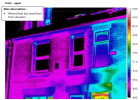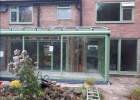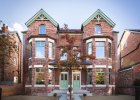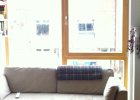Green Open Homes Greater Manchester
19 - 20 Oct 2019
For more information and tickets: www.eventbrite.co.uk/e/virtual-green-homes-qa-with-homeowners-tickets-419705148397
This event has now finished.
Other Andy will be joining our online Q&A session
Andy and Sue have been creating a sustainable, comfortable and beautiful home for over 40 years. They have thought carefully about how to use the natural resources on their land to create energy and keep warm! They have taken care of the natural environment, managed water, solar and land resources while maintaining a low carbon footprint and increasing biodiversity.
Andy is a fountain of knowledge and always happy to discuss energy efficiency and sustainability. More recently he has learnt lots about managing water resources due to the summer drought.
Bank Nook is a detached 1750 stone built cottage, 250 metres high on West Pennine Hills, 115 sq metres.
Energy Saving Improvements
Low cost improvements
Draught proofing, hot water pipe insulation
‘Big’ insulation works
Internal insulation - Pavadentro, Hemp Lime, Fibre glass, recycled plastic bottles. Kingspan in cavity and under floors.
Glazing upgrades
High quality double glazing.
Lighting systems and electrical appliances
All LED lights, Induction hob etc.
Heating system upgrades
Mitsubishi 5kW ASHP [Air Source Heat Pump] operating with seasonal COP of 4+ recorded by Mitsubishi Field trails.
Renewables: heat
ASHP as above, wood stove using wood grown on site.
Renewables: electricity
2.5 kW PV panels on purpose built shed with integrated greenhouse.
Water management
Spring supply with 1 year storage - 60,000 litres - renovated 1870 tank.
Use of sustainable building materials
Some wood from trees I planted used for PV shed, Pavadentro.
Any other improvements
Rich ecology from 2,000 trees planted 1977-79, Food production from innovative raised beds, and Fruit cage, Raspberries naturalised across site.
Timeline
1977-1979 2000 trees planted. Now yielding over a ton of firewood each year and rich ecology. Natural water supply developed. Improved 1994 and 2013.
1977-1995 Insulation on East side of the house, Conservatory built on south side for solar gain, etc
1995 Installed water source Heat Pump with underfloor heating beneath stone flags
2009 Highly insulated extension built on North side
2010 Installed Air Source Heat Pump (£6,000 approx)
2011 Installed PV panels on purpose built shed with integrated Greenhouse
2012 - 14 Pavadentro and Hemp Lime insulation installed on West Side (£6,000 for 30 sq metres).
Background and motivations
What motivated you to make these measures?
1975 book Energy for survival, and 1975 Ecology Magazine special Blueprint for Survival - early visits to CAT [the Centre for Alternative Technology] and member of AECB [Association for Environment Conscious Building].
Why did you choose these particular measures?
Necessity to tackle Climates and resource issues globally.
What did the work entail for you? Did you do works yourself or hire someone else? How did you find and choose a builder/supplier?
I was a builder, and then advised on retrofit etc., over 40 years becoming a senior consultant to the European Commission in Urban sustainability.
What difference has these measures made in your home (e.g., reduced energy use, saved money on bills, more comfortable)? If you track any changes quantitatively, how do you do this?
Energy all green electric, approx 2 mWhrs pa. records of energy use. 60% floor area has underfloor heating - very comfortable.
What key dos and don'ts would you pass on to someone considering these works?
Don't follow MCS advice on HPs - Consult BRE and Heatpumps.co.uk.
Get your info from anywhere except Westminster gov - Scotland, Wales, France, Germany etc.
AECB and CAT are good sources of info.
Relevant links
Andy Hamilton - 38 Years in to a 40 Year Project: https://vimeo.com/141839598



